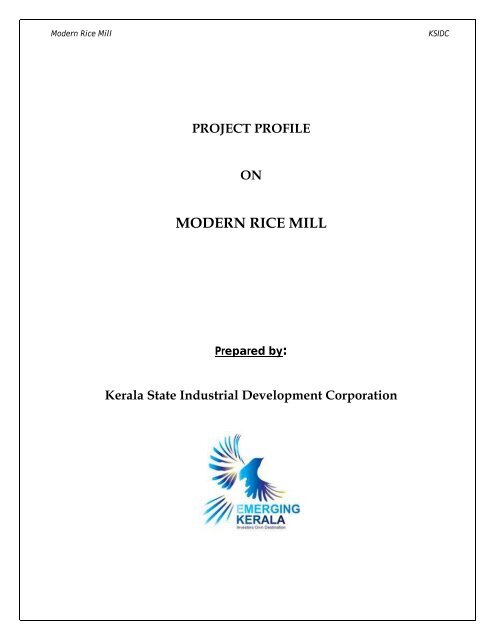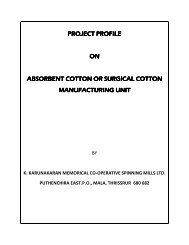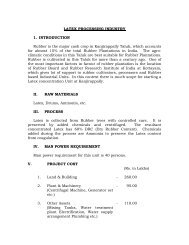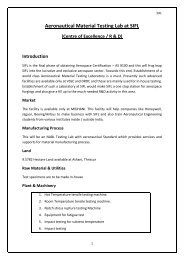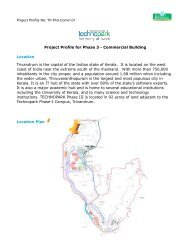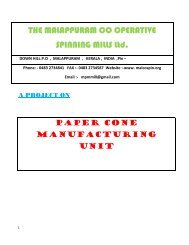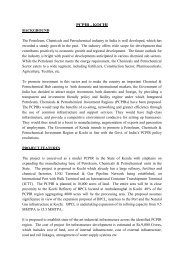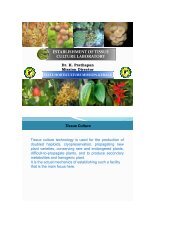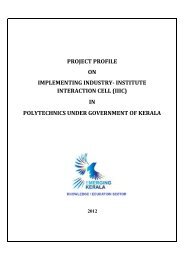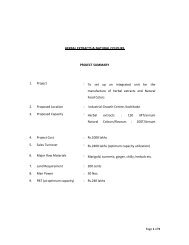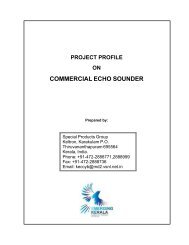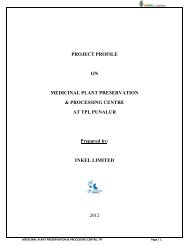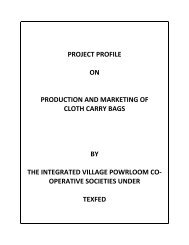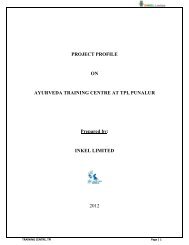project profile on modern rice mill - Emerging Kerala
project profile on modern rice mill - Emerging Kerala
project profile on modern rice mill - Emerging Kerala
Create successful ePaper yourself
Turn your PDF publications into a flip-book with our unique Google optimized e-Paper software.
Modern Rice Mill<br />
KSIDC<br />
PROJECT PROFILE<br />
ON<br />
MODERN RICE MILL<br />
Prepared by:<br />
<strong>Kerala</strong> State Industrial Development Corporati<strong>on</strong>
Modern Rice Mill<br />
KSIDC<br />
PROJECT PROFILE FOR MODERN RICE MILL<br />
INTRODUCTION<br />
Rice is a vital food material for more than half of the world’s populati<strong>on</strong>, the importance of<br />
which as a food crop has been increasing with increase in populati<strong>on</strong>. It is estimated that the<br />
<strong>rice</strong> requirement for <strong>Kerala</strong> is about 7500 t<strong>on</strong>nes per day whereas the producti<strong>on</strong> within the<br />
state is grossly inadequate to meet the requirement. The productivity of paddy in the State at<br />
the current level is sub optimal, meeting <strong>on</strong>ly 15% of the requirement, and the remaining<br />
85% requirement is met from the neighbouring states of Tamil Nadu, Andhra Pradesh and<br />
Karnataka.<br />
Modern Rice Mills are scientifically up-to-date units, with most <strong>modern</strong> plant and<br />
machinery. Rice produced in a Modern Mill would be of superior quality and thereby<br />
finding greater customer acceptance. Further, the bye-product of such Mills, Rice bran, could<br />
find great demand as raw material am<strong>on</strong>g solvent Extracti<strong>on</strong> Plants.<br />
MARKET<br />
At present, the paddy <strong>mill</strong>ing capacity available in the State is about 3000-3500 T<strong>on</strong>s per day<br />
giving an output of <strong>on</strong>ly about 2000 T<strong>on</strong>s of <strong>rice</strong> per day, leaving a huge gap which is being<br />
met by Public Distributi<strong>on</strong> System (PDS) and by import of paddy/ <strong>rice</strong> from other states. As<br />
per figures from Rice Mills Owners Associati<strong>on</strong>, there are about 125 <strong>rice</strong> <strong>mill</strong>s operating in<br />
the State, out of which about 50% are <strong>modern</strong> sophisticated units with Whitener and Color<br />
Sorter machinery and others are partially <strong>modern</strong>ized or upgraded from the traditi<strong>on</strong>al Rice<br />
Mills (by incorporating dryer systems). The remaining units are having a capacity to process<br />
<strong>on</strong>ly about 10 T<strong>on</strong>s of paddy per week. Rice Mills in <strong>Kerala</strong> are meeting <strong>on</strong>ly 20% of the<br />
State’s requirements and the balance is met by PDS and from other states. So the Demand-<br />
Supply gap is huge and there is sufficient scope for more Rice Mills.<br />
MANUFACTURING PROCESS<br />
The manufacturing process employed in a Modern Rice Mill is c<strong>on</strong>tinuous and fully<br />
automatic, c<strong>on</strong>sisting of Paddy Cleaning, Par Boiling, Drying, Milling, Sorting and Packing.<br />
The Cleaning secti<strong>on</strong> c<strong>on</strong>sists of raw paddy cleaners, de-st<strong>on</strong>er and dust blowers, where the<br />
dust, mud, st<strong>on</strong>es and immature paddy are removed to make it completely free from the<br />
foreign materials. The next stage is a pre-<strong>mill</strong>ing process called Parboiling, which is the<br />
partial cooking of the grain with husk, d<strong>on</strong>e to impart the required hardness to paddy grains<br />
so as to withstand the pressure exerted during the Milling process. The parboiled paddy is<br />
taken to the Drying secti<strong>on</strong> which c<strong>on</strong>sists of the Drying plant, Heat exchanger and Blower.<br />
The steam produced by the boiler is used for drying the paddy in the drier. The drying time
Modern Rice Mill<br />
KSIDC<br />
can be altered by adjusting the temperature of the drier. When the paddy is sufficiently dry,<br />
it is taken to the Milling secti<strong>on</strong>. Milling is the process of removing husk from paddy by<br />
applicati<strong>on</strong> of force through a rubber roller. Milling secti<strong>on</strong> c<strong>on</strong>sists of a Rubber Sheller,<br />
C<strong>on</strong>e Polishers, Bran Blower and Separator, De-st<strong>on</strong>er and a Vibrator machine. The paddy<br />
husk is collected in a separate room and is used as the fuel for firing the boiler, or sold<br />
loosely for making cattle feed, manure, etc.<br />
The shelled paddy is then directed to the Paddy Separator, which will separate the unshelled<br />
paddy and the <strong>rice</strong>. The unshelled paddy will again go back to the Rubber Sheller and the<br />
shelled paddy is taken to the first C<strong>on</strong>e Polisher, where the <strong>rice</strong> bran is also removed from<br />
the <strong>rice</strong>. This will then go to the Bran Blower and Separator, which will completely remove<br />
the bran from the product. The bran will be collected in a separate room and will be sold to<br />
the c<strong>on</strong>sumers directly. The hulled paddy is again taken to the sec<strong>on</strong>d and third C<strong>on</strong>e<br />
Polishers for polishing the <strong>rice</strong>. After polishing, the <strong>rice</strong> will move to the de-st<strong>on</strong>er and<br />
vibrator, where st<strong>on</strong>es and broken <strong>rice</strong> are completely removed from the product to make it<br />
superior in quality. The <strong>rice</strong> collected at the end of the <strong>mill</strong>ing secti<strong>on</strong> then moves to the<br />
Colour Sorter for removing the black and immature <strong>rice</strong> completely. The product is then<br />
moved to the Packing Secti<strong>on</strong> for packing in different sizes of polythene and gunny bags,<br />
weighed, stitched and taken to the store room for dispatch.<br />
PROJECT PARAMETERS<br />
• Capacity<br />
The processing capacity envisaged for a medium capacity Modern Rice Mill is 60T<strong>on</strong>s/day<br />
(18000 TPA). Plant operati<strong>on</strong> will be <strong>on</strong> a 2-shift basis of 8 hours/shift.<br />
• Land<br />
An extent of around 1 acre of dry land is required for setting up a Modern Rice Mill.<br />
• Locati<strong>on</strong><br />
The <str<strong>on</strong>g>project</str<strong>on</strong>g> is proposed to be located at Palakkad District.<br />
• Raw Material & Utilities<br />
Paddy is the raw material for the Modern Rice Mill. At 100% installed capacity, the total<br />
Paddy requirement per annum would be 18000 T<strong>on</strong>s.<br />
• Plant & Machinery<br />
The machinery/ equipments required for a Cold Storage Plant is as follows:<br />
Sl. No. Particulars Rs. Lakhs<br />
1 Cleaning Secti<strong>on</strong> 15.00<br />
2 Par Boiling Unit 32.00
Modern Rice Mill<br />
KSIDC<br />
3 Dryer System 30.00<br />
4 Milling Secti<strong>on</strong> 60.00<br />
5 Boiler & Accessories 30.00<br />
6 Rice Colour Sorter 25.00<br />
7 Packing Secti<strong>on</strong> 18.00<br />
Total 210.00<br />
The total cost of plant & machinery for a 18000TPA Modern Rice Mill would be around<br />
Rs.210 Lakhs. However, the actual costs may vary depending up<strong>on</strong> the<br />
manufacturer/supplier.<br />
• Manpower<br />
The total manpower requirement for a 18000TPA Modern Rice Mill would be around 30<br />
numbers. This includes managerial staff, skilled and unskilled labourers.<br />
• Cost of the Project<br />
The total <str<strong>on</strong>g>project</str<strong>on</strong>g> cost for setting up a 18000TPA Modern Rice Mill would be in the range of<br />
Rs.500-550 Lakhs, including cost of 1 acre land. The <str<strong>on</strong>g>project</str<strong>on</strong>g> implementati<strong>on</strong> period would be<br />
12 m<strong>on</strong>ths.<br />
Project Comp<strong>on</strong>ents<br />
Cost<br />
(Rs. Lakhs)<br />
Land (1 acre) & Land Devpt 50.00<br />
Building & Civil works (Total built-up area of 24700 sq. ft) 140.00<br />
Plant & Machinery 210.00<br />
Utilities 18.00<br />
Technical Know how 5.00<br />
Misc. Fixed Assets 25.00<br />
Preliminary & Pre-operative expenses 26.00<br />
C<strong>on</strong>tingencies 20.00<br />
Margin m<strong>on</strong>ey 56.00<br />
Total Project Cost 550.00<br />
• Means of Finance<br />
The proposed means of Finance for the Project is given below:<br />
Equity<br />
Promoters c<strong>on</strong>tributi<strong>on</strong> 200.00<br />
Subsidy 15.00<br />
Unsecured Loan 60.00<br />
Term Loan<br />
KSIDC/KFC/Banks/FIs 275.00<br />
Total Project Cost 550.00
Modern Rice Mill<br />
KSIDC<br />
The Debt-Equity ratio is 1:1.<br />
• Sales Turnover<br />
The Revenue at optimum utilisati<strong>on</strong> (80% from the 3 rd year <strong>on</strong>wards) would be around Rs.<br />
2670 Lakhs. The capacity utilisati<strong>on</strong> for the first and sec<strong>on</strong>d years of operati<strong>on</strong> is assumed to<br />
be 60% & 70% respectively.<br />
FINANCIAL INDICATORS<br />
• The Profit after Tax is Rs.107 Lakhs.<br />
• The Break Even Point (BEP) for the <str<strong>on</strong>g>project</str<strong>on</strong>g> is 57%.<br />
• The Debt Equity Ratio (DER) for the <str<strong>on</strong>g>project</str<strong>on</strong>g> is 1:1<br />
• Average Debt Service Coverage Ratio (DSCR) is 3.11<br />
• The average Internal Rate of Return (IRR) for the <str<strong>on</strong>g>project</str<strong>on</strong>g> is 22%.<br />
CONCLUSION<br />
There is tremendous potential for marketing Sortex Rice in the State, mainly through<br />
wholesale merchants at Palakkad, Alappuzha, Thrissur, Malappuram, Kozhikode and<br />
Kannur. By setting up a Modern Rice Mill with large capacity, competitive p<strong>rice</strong> could be<br />
quoted due to ec<strong>on</strong>omies of scale. Marketing is not at all a problem <strong>on</strong>ce the quality<br />
standards and distributi<strong>on</strong> channels are established. There is also great potential for exports<br />
to Middle East countries, as India is the major exporter of Rice to the Middle East.<br />
The broken <strong>rice</strong>, <strong>rice</strong> bran and husk could be sold in domestic market. Rice bran finds good<br />
buyers am<strong>on</strong>g solvent extracti<strong>on</strong> units both within and outside <strong>Kerala</strong>. Rice bran also could<br />
be sold to units manufacturing fodder viz. Milma, Lipt<strong>on</strong>, Godrej, KSE Ltd, <strong>Kerala</strong> feeds etc,<br />
to name a few.<br />
********<br />
For further details please c<strong>on</strong>tact <strong>Kerala</strong> State Industrial Development Corporati<strong>on</strong> Ltd.<br />
Disclaimer:<br />
The findings c<strong>on</strong>tained in this Project Profile are based <strong>on</strong> the initial informati<strong>on</strong> collated through primary and sec<strong>on</strong>dary<br />
research, which is indicative in nature. Reference herein to any specific commercial product, process, service by trade name,<br />
trademark, manufacturer, or otherwise, does not c<strong>on</strong>stitute or imply its endorsement, recommendati<strong>on</strong>, or favoring by<br />
KSIDC or any entities thereof.


